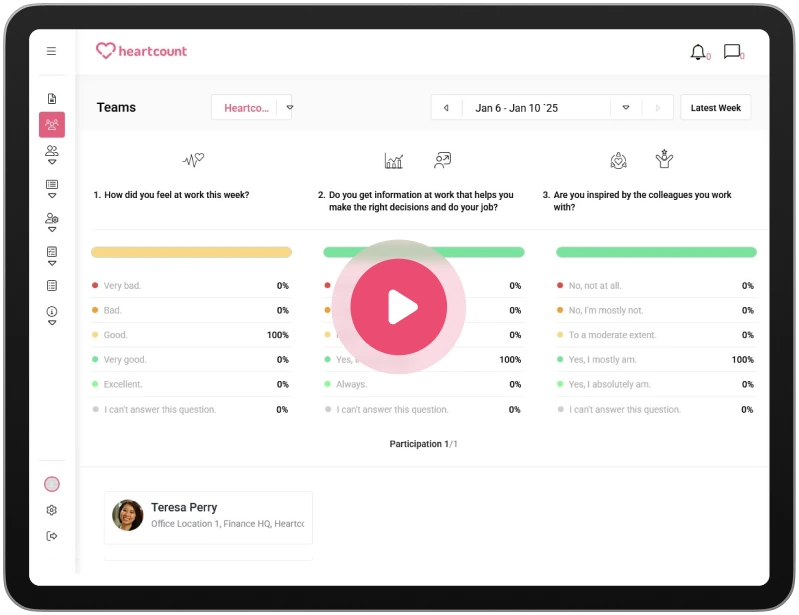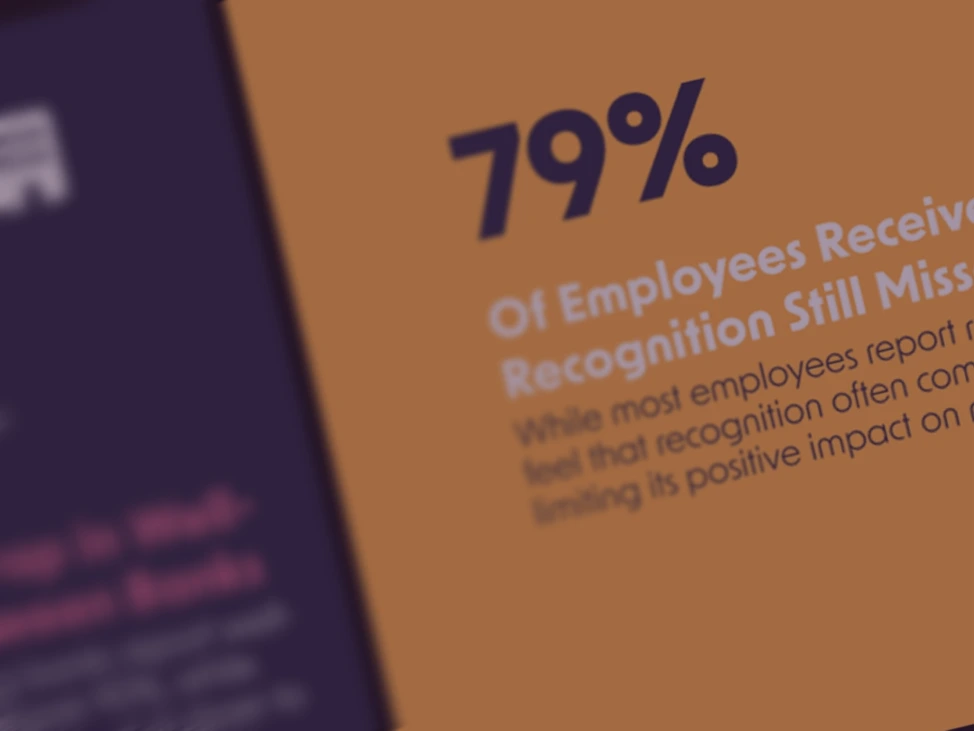What is job satisfaction, and why is it important?

The great American philosopher and poet Henry David Thoreau famously said,
“The price of anything is the amount of life you exchange for it.”
It’s estimated that the average person spends a third of her life at work, or just under 90,000 hours in a lifetime.
Imagine that person spending a third of her life at a job she does not like, and that does not make her fulfilled and happy. As her manager, could you honestly expect and ask her to do her best work?
Job satisfaction is essential for employees to feel motivated and engaged at work and for the team, department, and organization. Because where one employee is dissatisfied, others soon follow.
-
1.What is job satisfaction?
-
2.What happens when people are not satisfied with their jobs?
-
3.How satisfied are people with their jobs today?
-
4.What leads to job dissatisfaction?
-
5.Job satisfaction vs job happiness - what’s the difference?
-
6.How do you measure employee satisfaction?
-
7.Why do you need to conduct employee satisfaction surveys?
-
8.How to improve job satisfaction?
-
9.Higher job satisfaction rate - higher performance
The great American philosopher and poet Henry David Thoreau famously said,
“The price of anything is the amount of life you exchange for it.”
It’s estimated that the average person spends a third of her life at work, or just under 90,000 hours in a lifetime.
Imagine that person spending a third of her life at a job she does not like, and that does not make her fulfilled and happy. As her manager, could you honestly expect and ask her to do her best work?
Job satisfaction is essential for employees to feel motivated and engaged at work and for the team, department, and organization. Because where one employee is dissatisfied, others soon follow.
What is job satisfaction?
One of the leading minds on goal setting, Edwin Locke, defined job satisfaction as:
“The pleasurable emotional state resulting from the appraisal of one’s job as facilitating the achievement of one’s job values.”
Job satisfaction reflects how the job and its environment meet a person’s needs and expectations. It’s mainly shaped by salary, job security, benefits, company culture, career opportunities, relationships, etc.
This includes salary and benefits, recognition in the workplace, a healthy work environment, career development opportunities, job security, autonomy at work, and more.
What happens when people are not satisfied with their jobs?
Employees can feel dissatisfied with their jobs for many reasons, including low salary, lack of good benefits, feeling skipped for a promotion they’ve been waiting for, poor relationships in the team or with the manager, and lack of opportunities for training and development.
Just as there are many reasons people might feel dissatisfied with their jobs, there are also a few ways they might express this dissatisfaction.
People typically express job dissatisfaction in one of three ways:
- Passively disengaging from work and doing the minimum required work
The trend of “quiet quitting” or doing the bare minimum at work and merely meeting the job description is growing fast.
According to McKinsey, quiet quitters make up between 20% and 40% of the organization’s workforce and are three times as likely to be dissatisfied as other employees.
Quiet quitters can be more dangerous than “real” quitters because, while they remain at the company, they can decrease productivity, increase absenteeism, negatively affect culture, increase turnover, and more.
- Actually quitting
While some people will choose to remain at the company and “only” mentally and emotionally disengage, most will quit “for real” if they don’t feel satisfied at work.
While you don’t want to see productive employees quit, you can still learn something from this by conducting exit interviews with those leaving.
This can tell you a lot about the problems they had in the company and what you can do to improve and reduce turnover.
- Voicing their dissatisfaction
There is a third group besides quitters and quiet quitters. This third group will express their dissatisfaction and concerns by communicating them to management directly or through employee surveys, meetings, or other formal channels.
This group can be the most valuable for your organization as it will provide feedback and suggest areas for improvement. Listening closely to them can have a positive effect, while ignoring them can only worsen things. Eventually, they too will grow tired and leave if they see you don’t hear and value them.
How satisfied are people with their jobs today?
On average, job satisfaction is on the rise. According to The Conference Board 2023 Job Satisfaction survey, in the US, it was at the highest level in over three decades that the survey has been conducted regularly.
The survey, which looked at 26 components of job satisfaction, reported an increase in satisfaction across all job components between 2021 and 2022.

Contrary to popular belief, a high salary does not make people satisfied with their jobs (though that certainly helps). Respect is even more important for many, as employees who feel respected are 63% more satisfied with their jobs.
What leads to job dissatisfaction?
Managers and team leaders must quickly identify and address the issues that lead to job dissatisfaction.
Unfortunately, according to a 2023 study by Pew Research Center, less than half (49%) of employees are satisfied with their jobs.

Of more than 5,000 full-time US adults working full-time who participated in this survey, 26% expressed dissatisfaction with their salary.
Yet, this isn’t the only factor that leads to job dissatisfaction.
According to the same survey, the leading factor in job dissatisfaction wasn’t the salary but the opportunities for promotion at work (32%), followed by how much they are paid (26%), benefits (21%), and opportunities for training and development (21%).
On the other end of the spectrum, only a small percentage of those surveyed said they feel satisfied with their relationship with co-workers (6%) and managers or supervisors (11%).
As you can see, many doors lead to job dissatisfaction. As a manager, team leader, or HR professional, you need to identify these doors and lock what’s behind them.
Job satisfaction vs job happiness – what’s the difference?
As an HR manager, recruiter, or team lead, you’ll often hear candidates or employees say they seek job satisfaction and happiness.
These terms look like they go together and are interchangeable, but they represent different things.
Happiness, in general, is the state and a sense of joy or contentment. Satisfaction, conversely, is the fulfillment of one’s wishes, expectations, or needs.
If we’re talking about work specifically, happiness at work is a state of contentment and emotional well-being that comes from engaging in meaningful and fulfilling activities at one’s work.
On the other hand, job satisfaction represents how the job meets the person’s needs and expectations and is the level of contentment the person feels about their work.
Here are the differences between the two:
| Job happiness | Job satisfaction | |
| Definition | A state of contentment and emotional well-being that comes from engaging in meaningful and fulfilling activities at one’s work. | How the job meets the person’s needs and expectations and is the level of contentment the person feels about their work. |
| Focus | Emotional well-being and fulfillment at work. | Specific aspects (salary, benefits, career development opportunities, job security…). |
| Duration | Long-term/Stable. | Short-term/Fluctuates. |
| Measurement | Usually through self-reports. | Typically, through surveys or feedback related to specific job elements. |
| Impact | Intangible factors (passion, personal growth…). | Tangible factors (job security, salary, career development…). |
| Scope | Broader. | Narrower. |
| Outcomes | The feeling of joy and enthusiasm towards the job. | Person’s contentment with their job. |
How do you measure employee satisfaction?
Job satisfaction influences employee productivity, effectiveness, and overall loyalty, so it’s crucial for a company to measure it.
There are 7 ways to measure job satisfaction:
- Job satisfaction surveys – A method or tool for gathering information about a specific issue (like job satisfaction) from an individual or group of people using relevant questions.
- Stay interviews – Usually, 1-on-1 discussions that aim to explore the employee’s opinions and feelings about the job.
- Exit interviews – An interview or discussion with an employee leaving the company to understand their reasons and gain insights into underlying issues.
- Employee feedback – Best done through employee feedback systems (EFS), where they can continuously provide feedback regarding their job satisfaction levels or workplace concerns.
- 360-degree feedback – Collect feedback from peers, supervisors, and other sources to understand the employee’s job satisfaction.
- Observation—Monitoring employee engagement, performance, interactions, or performance to determine job satisfaction levels.
- Focus groups – Facilitated group interviews consisting of a small number of pre-defined participants whose reactions to specific questions are studied by the researcher/evaluator.
While all of these methods can help you measure job satisfaction, directly or indirectly, job satisfaction surveys stand out as the most effective approach, so we’ll focus on them here.
Why do you need to conduct employee satisfaction surveys?
Conducting employee satisfaction surveys is very important to understand how the employees feel at work (are they happy or unhappy).
This allows HR managers to gather valuable insights, proactively address issues like increased turnover or absenteeism, and identify industry benchmarks and the company’s position.
For team and department managers, employee satisfaction surveys highlight areas for improvement and areas of strength while also improving employee-manager communication.
Finally, businesses gain valuable insights through the data gathered in these surveys, which help them make informed decisions and strategically plan their following goals.
What are the benefits of employee satisfaction surveys?
Employee satisfaction surveys provide several benefits, such as:
- Honest communication between employees and management
- Direct employee feedback
- Increased retention rate
- Valuable insight into satisfaction over time
- Data-driven decision-making
- Anticipation and prevention of employee turnover
What questions should you ask in a job satisfaction survey?
There are dozens of questions that you can include in an employee satisfaction survey, so choosing the right questions is essential.
One of the most significant benefits of using HeartCount is that you can tailor surveys to your needs. For instance, you can create a survey with just one or 50 questions, send it to one employee, a team, or everybody in your organization, and choose different response formats, such as multiple-choice, open-ended, etc.
For example, here are some questions you can ask to understand job satisfaction in your employees:
- Taking everything into account, how satisfied are you with your job?
- Rate your work-life balance on a scale of 1 to 5 (1 = very poor, 5 = excellent)
- How likely would you recommend our company as a good workplace?
- How well does the job description match your current role?
- Is the work evenly distributed in your team?
- Do you have everything you need (equipment, material…) to do your work successfully?
- Do you feel valued for what you do at work?
Essential steps and tips for creating a good employee satisfaction survey
Conducting an employee satisfaction survey involves several steps.
- Understand the survey goals or objectives.
Design and implement the survey with a clear goal in mind that leads to actionable outcomes (i.e., what actions you plan to take based on it).
- Creating the questionnaire
Surveys and questionnaires are different. A questionnaire is just one part of the survey in which you ask a set of questions to the employees, while a survey is the entire process of collecting, analyzing, and interpreting the data you get from them.
- Communication and instructions
Announce the survey before distributing it, explain why you’re conducting it (purpose), and explain why participation is essential.
- Distributing the survey
Next, you need to distribute the survey to employees. Ensure it is accessible to those working remotely and those with disabilities. Surveys can be distributed electronically, through a survey platform, or in paper form (if you feel traditional).
- Collecting data
The survey should be completed within a specific timeframe, so ensure the participants complete it within that time frame. Send reminders for the tardy ones and track their response rate to ensure you have a representative sample.
- Analyzing data
Once you’ve collected the data, you must ensure its accuracy. Clear any false, double, or irrelevant data you have. Next, you can use different analytical tools to identify patterns and trends.
- Reporting
Summarize your data clearly and concisely. It’s best to highlight critical points using tables, charts, graphs, and other visual aids rather than regular text. With your data now tidy, you can present it to management and share it with employees to ensure transparency.
- Action plan
Based on the results, identify areas that need your attention and create specific action plans to address these issues.
- Following-up
Finally, don’t stop here. Implement the action plan, communicate your changes with employees and management, and monitor their impact.
With HeartCount, you can gather employee feedback through custom surveys. You can tailor questions and timing and select specific employees. All your surveys can be saved as templates to reuse them effortlessly.

How to improve job satisfaction?
Employee satisfaction and organizational success are connected; without the first, there’s usually no second.
This is why everything you can do to maintain high job satisfaction and improve it in your team or organization matters.
Here are some best practices you can use:
- Create and foster a positive work environment through transparency, trust, listening, and building healthy team relationships.
- Help employees develop and grow their skills.
- Recognize and reward good performance and effort from employees (give kudos)
- Allow employees to focus on meaningful work and reduce or eliminate inefficient and ineffective work.
- Hand the controls to the employees on how they can shape their work.
- Measure employee satisfaction regularly and take action based on what you learn.
- Provide regular feedback to employees
- Clearly define your company mission, goals, and objectives
Higher job satisfaction rate – higher performance
Companies with higher job satisfaction outperform those with low satisfaction by 202%.
This is because satisfied employees are more engaged and motivated and, therefore, more productive and efficient.
Ignoring your employees’ dissatisfaction can only hurt your business, so keep your finger on the pulse and sign up for a free 14-day trial of HeartCount.








